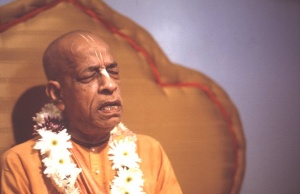SB 1.7.4 (1962)

A.C. Bhaktivedanta Swami Prabhupada
TEXT No. 4
Bhakti yogena manasi samyak pranihite amale Apasyat purusham purnam mayam cha tad apashrayam
ENGLISH SYNONYMS
Bhakti—devotional service, Yogena—by the process of linking up, manasi—upon the mind, Samyak—perfectly, Pranihite—engaged in fixed up, Amale—without anything of matter, Apasyat—saw, Purusham—the Personality of Godhead, Purnam—absolute, mayam—energy, Cha—also, Tad—His, Apashrayam—under full control.
TRANSLATION
Thus He fixed up His mind perfectly engaged in the linking up process of devotional service without any tinge of material affection and He saw the Absolute Personality of Godhead along with His external energy under full control.
PURPORT
Perfect vision of the Absolute Truth is possible only by the linking process of devotional service. This is also confirmed in the Bhagwat Geeta that one can perfectly realise the Absolute Truth Personality of Godhead only by the process of devotional service and one can enter into the Kingdom of God by such perfect knowledge. Imperfect realisation of the Absolute by partial approach of impersonal Brahman or localised Paramatma does not permit anyone to enter into the Kingdom of God. Sri Narada advised Srila Vyasdeva to become absorbed in transcendental thinking of the Personality of Godhead and His activities. Srila Vyasadeva did not take any notice of the effulgence of Brahman because that is not Absolute vision. The Absolute Vision is the Personality of Godhead as it is confirmed in the Bhagwat Geeta Vasudeva Sarvam iti. In the Upanishads also it is confirmed that Vasudeva the Personality of Godhead is covered by golden glowing Hiranmoyena patrena veil of Impersonal Brahman and when that curtain is removed by the mercy of the Lord the real Face of the Absolute is seen. The Absolute is mentioned here as the Purusha or the Person. The Absolute Personality of Godhead is mentioned in so many Vedic literatures and in the Bhagwat Geeta the Purusha is confirmed as eternal and the Original Person. The Absolute Personality of Godhead is the Perfect Person. The Supreme Person has manyfold energies out of which the internal external and the marginal energies are specifically important. The energy mentioned here is the external energy as it will be clear from the statements of her activities. The internal energy is there along with the Absolute Person as the moon light is seen along with the moon. The External energy is compared with darkness because she keeps the living entities in the darkness of ignorance. The word Apashrayam suggests that this energy of the Lord has no inferior complex in comparison with the superior energy called by the name Internal Potency. The internal potency is also called Maya but it is spiritual Maya or energy exhibited in the Absolute realm. When one is under the shelter of this internal potency the darkness of material ignorance is at once dissipated. And even those who are Atmarama or fixed up in trance do also take shelter of this Maya or internal energy. Devotional service mentioned as Bhaktiyoga is the function of the internal energy; as such there is no place for the inferior energy or material energy as much as there is no place for darkness in the effulgence of spiritual light. Such internal energy works even superior to the spiritual bliss attainable in the conception of impersonal Brahman. As it is stated in the Bhagwat Geeta that such impersonal Brahman effulgence is also an emanation from the Absolute Personality of Godhead Sri Krishna. The Parama Purusha cannot be anyone except Sri Krishna Himself as it will be explained in the later slokas.